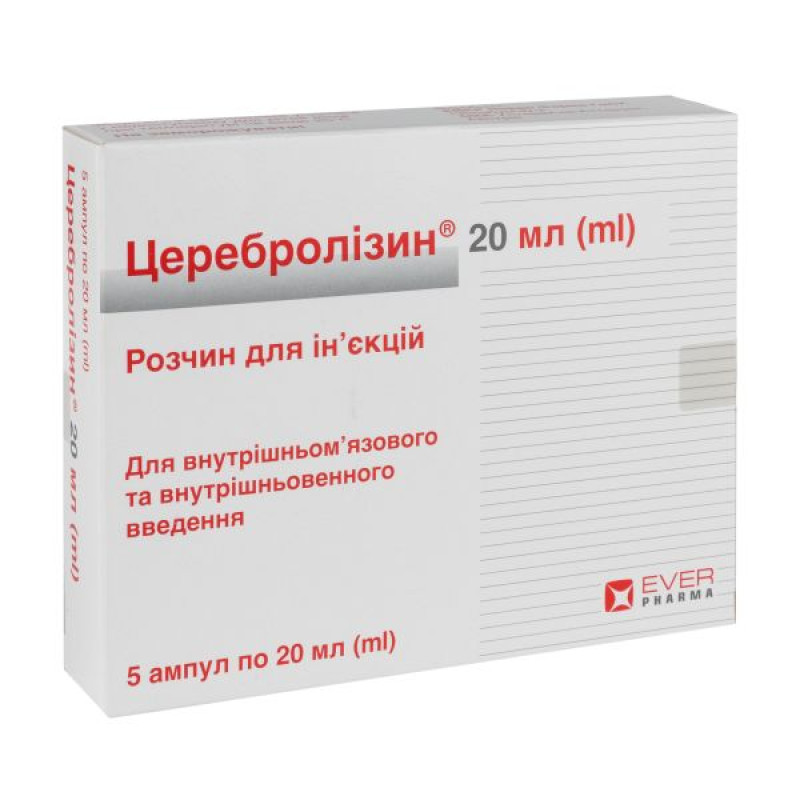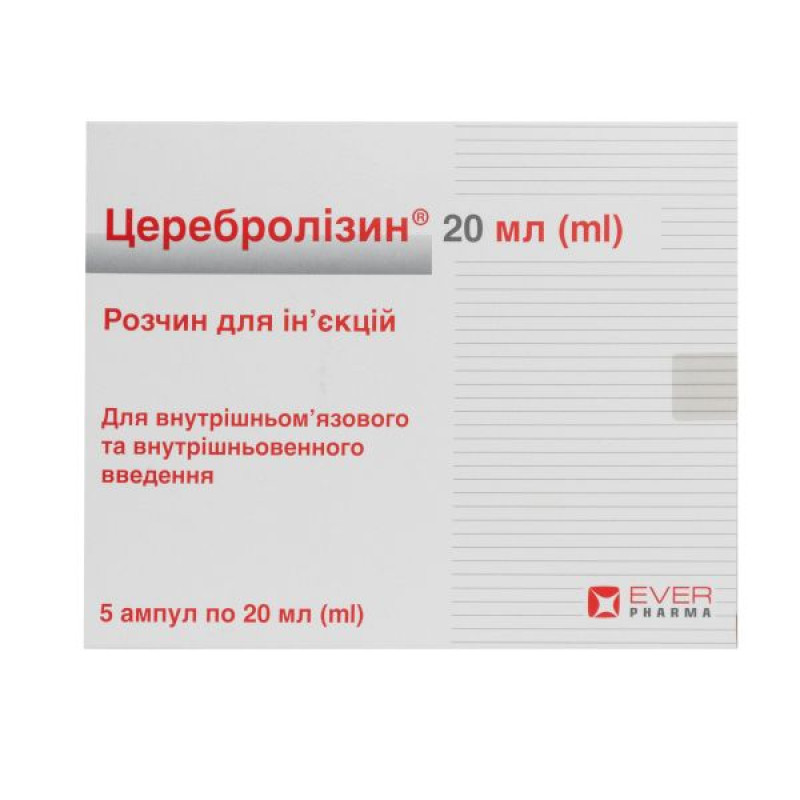Cerebrolysin solution for injection 215.2 mg/ml ampoule 20 ml No. 5

Instructions Cerebrolysin solution for injection 215.2 mg/ml ampoule 20 ml No. 5
Composition
active ingredient: Cerebrolysin® concentrate;
1 ml of solution contains 215.2 mg of Cerebrolysin® concentrate (a peptide preparation produced from pig brains);
Excipients: sodium hydroxide, water for injections.
Dosage form
Solution for injection.
Main physicochemical properties: transparent amber solution.
Pharmacotherapeutic group
Psychostimulants and nootropics.
ATX code N06B X.
Pharmacological properties
Pharmacodynamics
The proteolytic peptide fraction obtained from pig brain stimulates cell differentiation, improves nerve cell function and activates protective and regenerative mechanisms. Animal experiments have shown that Cerebrolysin® directly affects neuronal and synaptic plasticity, which contributes to the improvement of cognitive functions. This was demonstrated in young, adult and old animals with impaired learning ability. In experiments with models of cerebral ischemia, Cerebrolysin® reduced the size of the infarct, prevented the formation of edema, stabilized microcirculation, normalized neurological and cognitive disorders and doubled survival rates. Positive results were also obtained in studies on models of Alzheimer's disease. In addition to its direct effect on neurons, Cerebrolysin® significantly increases the number of molecules that ensure the transport of glucose across the blood-brain barrier, thus compensating for the critical energy deficit observed in this disease.
Quantitative analysis of electroencephalograms of healthy volunteers and patients with vascular dementia showed a significant dose-dependent increase in neuronal activity (increase in alpha and beta rhythm frequencies) after four weeks of treatment with Cerebrolysin®. Regardless of the causes of the disease, both in neurodegenerative dementia of the Alzheimer's type and in vascular dementia, after treatment with Cerebrolysin®, patients objectively improve cognitive functions and self-care ability. Clinically noticeable improvement in the condition of patients is observed after two weeks of treatment with the drug and increases with continued therapy. A positive effect of therapy with Cerebrolysin® is noted in 60–70% of patients regardless of the type of dementia. In the case of senile dementia of the Alzheimer's type, the improvement in the clinical condition of patients is maintained after the end of active therapy. This especially applies to the long-term improvement in the ability to perform daily activities, as a result of which the need for external care and supervision of patients is reduced. Due to its neurotrophic activity (similar to the action of nerve growth factor), Cerebrolysin® can significantly slow down, and in some cases, stop the progression of neurodegenerative processes.
High molecular weight peptides with antigenic potential are removed from the drug during the manufacturing process.
Studies have not shown any effect of the drug on the immune system. Experiments have shown that Cerebrolysin® does not cause the formation of antibodies or anaphylactic reactions.
Cerebrolysin® does not stimulate histamine receptors and does not affect erythrocyte hemagglutination.
Pharmacokinetics
Since the proteolytic peptide fraction obtained from the brain of pigs contains short biologically active peptides similar or identical to those produced endogenously, it has not been possible to directly measure the pharmacokinetic parameters of the drug Cerebrolysin® so far. Indirect pharmacokinetic data were obtained on the basis of studying the pharmacodynamic profile of the drug. The neurotrophic activity of the drug Cerebrolysin® in the blood plasma is detected within 24 hours after a single administration. The components of the drug can cross the blood-brain barrier. Preclinical in vivo experiments have revealed identical pharmacodynamic effects of the drug on the central nervous system after intracerebroventricular and peripheral administration. This is indirect evidence that the components of the drug overcome the blood-brain barrier.
Indication
Organic, metabolic disorders and neurodegenerative diseases of the brain, especially senile dementia of the Alzheimer's type.
Complications after stroke.
Traumatic brain injuries (conditions after brain surgery, closed head injuries, concussion).
Contraindication
Hypersensitivity to any of the components of the drug.
Epilepsy.
Severe renal dysfunction.
Interaction with other medicinal products and other types of interactions
Given the pharmacological profile of Cerebrolysin®, special attention should be paid to possible additive effects when combined with antidepressants or MAO inhibitors. In such cases, it is recommended to reduce the doses of antidepressants.
Cerebrolysin® should not be mixed with balanced amino acid solutions in the same infusion bottle.
Cerebrolysin® can be used simultaneously with vitamins and cardiovascular drugs, but they should not be mixed in the same syringe.
Application features
Particular caution is required when prescribing Cerebrolysin® to patients with allergic diathesis.
Although there is no evidence that Cerebrolysin® can increase the burden on the kidneys, the drug should not be administered to patients with severe renal insufficiency.
This medicinal product contains 2.57 mg sodium per ml of solution, equivalent to 0.13% of the recommended maximum daily intake of sodium for adults. Caution should be exercised when used in patients on a controlled sodium diet.
Use during pregnancy or breastfeeding
Animal studies have not revealed reproductive toxicity of the drug. However, data on the effect of the drug on human reproductive function are not available. Cerebrolysin® can be used during pregnancy only after a careful assessment of the ratio of the expected benefit to the woman and the potential risk to the fetus/child. Breastfeeding should be discontinued during the period of use of the drug.
The ability to influence the reaction speed when driving or working with other mechanisms
Clinical studies have not revealed any effect of the drug on the reaction speed when driving or using other mechanisms, however, in some patients Cerebrolysin® may cause certain undesirable side effects from the nervous system and mental sphere, which may temporarily impair the ability to drive or use other mechanisms.
Method of administration and doses
The drug must be administered intravenously or intramuscularly.
Undiluted Cerebrolysin® can be administered in doses up to 5 ml intramuscularly and up to 10 ml by intravenous injection. The drug in doses from 10 to 50 ml (maximum dose) is recommended to be administered only by slow intravenous infusions after dilution to a volume of 100 ml with one of the standard solutions listed below. The duration of infusions should be from 15 to 60 minutes.
After dilution with 0.9% sodium chloride solution (9 mg NaCl/ml), Ringer's solution (Na+ 153.98 mmol/l, Ca2+ 2.74 mmol/l, K+ 4.02 mmol/l, Cl– 163.48 mmol/l) or 5% glucose solution, the infusion solution is physically and chemically stable for 24 hours when stored at room temperature and protected from light. From a microbiological point of view, the infusion solution should be administered immediately after preparation.
The optimal recommended duration of treatment is 10–20 days with daily administration of the drug.
Single administrations in doses up to 50 ml are possible, but course therapy is more effective.
Recommended daily doses:
Organic, metabolic disorders and neurodegenerative diseases of the brain, especially senile dementia of the Alzheimer's type 5–30 ml
Complications after stroke 10–50 ml
Traumatic brain injuries 10–50 ml
For children 1–2 ml
The effectiveness of therapy usually increases with repeated courses. Treatment should be continued until the patient's condition improves as a result of therapy. After the initial course, the frequency of administration of the drug can be reduced to 2 or 3 times a week. Between courses of therapy, it is necessary to take breaks of at least the duration of the course of treatment.
The recommended dose for children aged 6 months and older is 0.1 ml/kg body weight (up to 2 ml per day).
Instructions to medical personnel
When administering Cerebrolysin® via an indwelling intravenous catheter, the system must be flushed with sodium chloride solution before and after infusion of the drug.
The drug should be withdrawn from the ampoule/vial immediately before use.
Only one-time withdrawal of the drug from the ampoule/vial is allowed.
Only a clear, amber solution can be used.
Children
The drug is used in pediatric practice if there are justified indications.
Overdose
There have been no reported cases of intoxication or adverse health effects due to an overdose of Cerebrolysin®.
Side effects
The following are the undesirable effects and reactions that occurred during clinical trials and post-marketing surveillance, regardless of the presence of a causal relationship with therapy with Cerebrolysin® (the drug is used to treat mainly elderly patients, and the indicated symptoms are often observed in this category of patients).
On the part of the immune system
Rare (<1/10,000) – hypersensitivity or allergic reactions, anaphylactic shock, angioedema, fever, chills.
Metabolic disorders
Rare (>1/10,000 - <1/1000) - loss of appetite.
Mental disorders
Rarely (>1/10,000 - <1/1000) - in isolated cases, the desired therapeutic effect was accompanied by agitation (with manifestations of aggression, confusion, insomnia), depression, apathy, weakness.
From the nervous system
Rarely (>1/10,000 – <1/1000) – with very rapid administration, dizziness, tremor, headache, drowsiness are possible.
Rare (<1/10,000) – grand mal seizures, convulsions.
Cardiovascular system
Rarely (>1/10,000 - <1/1000) - arterial hypertension, arterial hypotension.
Rare (<1/10,000) - with very rapid administration, palpitations, tachycardia and arrhythmia, and heart pain are possible.
Respiratory system
Gastrointestinal tract
Rare (<1/10,000) – dyspepsia, diarrhea, constipation, nausea, vomiting.
Skin and subcutaneous tissue disorders
Rarely (>1/10,000 - <1/1000) - with very rapid administration, a feeling of heat, increased sweating, itching, rashes, including maculopapular, urticaria, redness of the skin are possible.
General reactions and local reactions
Rarely (>1/10,000 - <1/1000) - increased fatigue, flu-like symptoms (e.g. runny nose, cough, respiratory tract infections).
Rare (<1/10,000) - injection site reactions, including erythema and burning at the injection site, local inflammatory reactions.
Other reactions
Rare (<1/10,000) – pain in the neck, limbs, lower back.
Expiration date
Cerebrolysin® in ampoules: 5 years.
Cerebrolysin® in vials: 2 years.
Storage conditions
Store in the original packaging out of the reach of children at a temperature not exceeding 25 °C. Do not freeze.
Incompatibility
Cerebrolysin® is incompatible with solutions that change the pH of the drug (5.0 - 8.0), as well as with solutions containing lipids.
Cerebrolysin® should not be mixed with balanced amino acid solutions, vitamins, and cardiovascular drugs in the same infusion bottle.
Packaging
1 ml in a brown glass ampoule; 10 ampoules in a cardboard box.
2 ml in a brown glass ampoule; 10 ampoules in a cardboard box.
5 ml in a brown glass ampoule; 5 ampoules in a cardboard box.
10 ml in a brown glass ampoule; 5 ampoules in a cardboard box.
20 ml in a brown glass ampoule; 5 ampoules in a cardboard box.
30 ml or 50 ml in a brown glass bottle, closed with a chlorobutyl rubber stopper with a fluoropolymer coating and an aluminum cap;
1 bottle in a cardboard box.
Vacation category
According to the recipe.
Producer
EVER Neuro Pharma GmbH, Austria.
EVER Neuro Pharma GmbH, Austria.
Location of the manufacturer and its business address/location of the applicant
Oberburgau 3, 4866 Unterach am Attersee, Austria.
Oberburgau 3, 4866 Unterach am Attersee, Austria.
There are no reviews for this product.
There are no reviews for this product, be the first to leave your review.
No questions about this product, be the first and ask your question.









